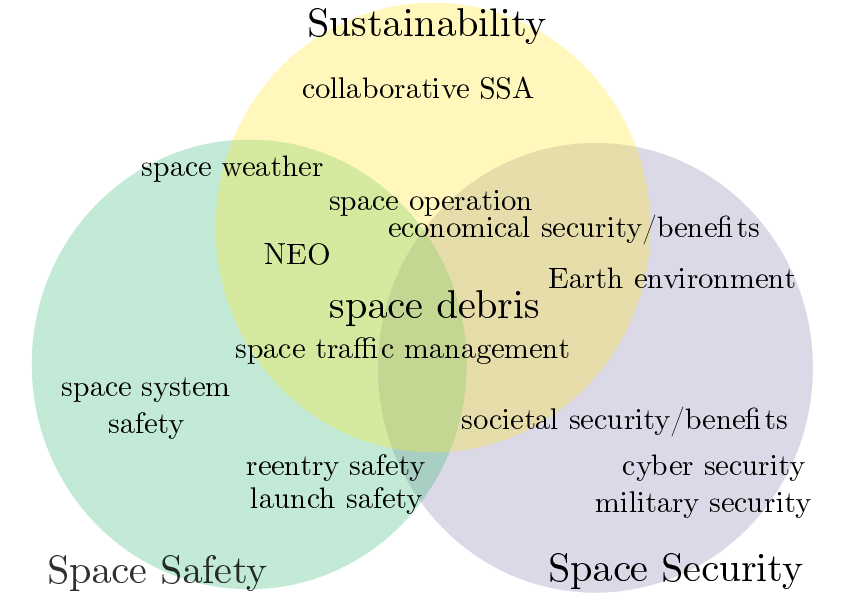
Disclaimer: Copyright infringement not intended.
Context
- On June 23, the U.K. hosted the fourth summit for Space Sustainability in London in collaboration with the Secure World Foundation.
Space Sustainiability
- Space sustainability is...
Ensuring that all humanity can continue to use outer space for peaceful purposes and socioeconomic benefit now and in the long term. This will require international cooperation, discussion, and agreements designed to ensure that outer space is safe, secure, and peaceful.
Background
- More than 1,800 satellites orbit the Earth. One of the challenges is increasing density of debris in orbit.
- Experts predict the debris population will reach a level at which it becomes self-sustaining: debris–on–debris collisions would continue to increase the amount of debris in orbit, even without new launches. This could quickly lead to a sharp decrease in our ability to sustain the benefits that space systems provide to the entire world.
Space Debris
- Space junk is any piece of machinery or debris left by humans in space—principally in Earth orbit.
- These include dead satellites, fragments of rocket bodies and spacecraft etc.
Concerns
- Currently, an estimated 20,000 objects—including satellites and space debris—are crowding low-Earth orbit. It can be a hazard to active satellites and spacecraft.
- At orbital velocities, even the tiniest pieces of debris can disable an operational satellite.
- Potential collision threat to the space station.
- Earth orbit could even become impassable if the risk of collision grows too high.
- It could hinder our ability to use weather satellites, and hence to monitor weather changes.
- Orbital crowding poses a direct threat to the operations and safety of a mission and is likely to cause legal and insurance-related conflicts.
Kessler syndrome
- This is an idea proposed by NASA scientist Donald Kessler in 1978.
- It says if there is too much space junk in orbit, it could result in a chain reaction where more and more objects will collide and create new space junk in the process, to the point where Earth's orbit became unusable – a Domino Effect.
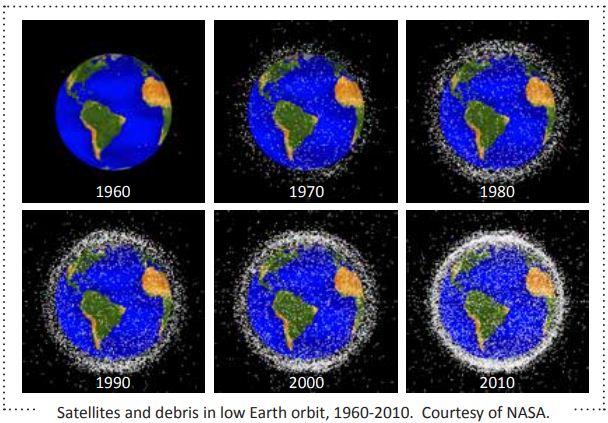
- 12 fragmentation events have already taken place every year for the past two decades.
- Hence, the issue of space sustainability is a new phenomenon that is gaining more attention in recent years as the launching of satellites and other space objects has increased. These launches have resulted in more space debris orbiting Earth, hindering the ability of nations to operate in the space environment while increasing the risk of a future launch-related accident that could disrupt its proper use.
- After the completion of a mission, an ‘end-of-life protocol’ requires space objects to be moved to the graveyard orbit or to a low altitude. Neither of the options are sustainable in the long run.
Inititiatives being taken
Outer Space Treaty
- The Outer Space Treaty, formally the Treaty on Principles Governing the Activities of States in the Exploration and Use of Outer Space, including the Moon and Other Celestial Bodies, is a multilateral treaty that forms the basis of international space law.
- Key provisions of the Outer Space Treaty include prohibiting nuclear weapons in space; limiting the use of the Moon and all other celestial bodies to peaceful purposes; establishing that space shall be freely explored and used by all nations; and precluding any country from claiming sovereignty over outer space or any celestial body.
Liability Convention (1972)
- Outlines the liability of launching states for damage caused by their space objects on the Earth or in space, and procedures for the settlement of claims for damages.
Moon Agreement (1984)
- Reaffirms and elaborates OST provisions applied to the exploration of the Moon and exploitation of resources found on the Moon. Though technically in force, this treaty has been ratified by relatively few countries and is ignored by most.
Elements of Space Governance
- Also include COPUOS endorsement of voluntary guidelines for orbital debris mitigation, negotiations to deal with space weapons and space security at the UN Conference on Disarmament, UN efforts to establish a plan to address the threat of potentially hazardous asteroids, negotiations between public and private entities on international civil space situational awareness, and other efforts.
Inter-Agency Space Debris Coordination Committee
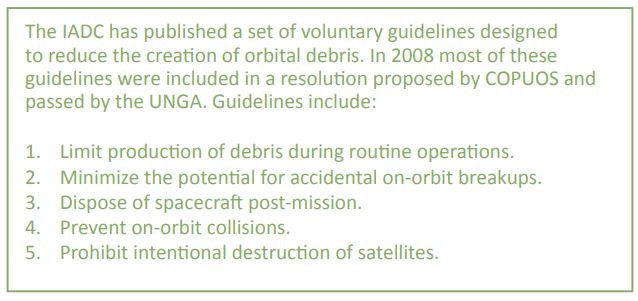
- IADC is an inter-governmental forum whose aim is to co-ordinate efforts to deal with debris in orbit around the Earth founded in 1993.
COPUOS
- As the outer space is considered a shared natural resource, the United Nations Committee on the Peaceful Uses of Outer Space (COPUOS) in 2019 adopted a set of 21 voluntary, non-binding guidelines to ensure the long-term sustainability of outer space activities.
LTS Working Group
- The Working Group was tasked with producing a set of voluntary guidelines for all space actors to help ensure the long-term sustainable use of outer space.
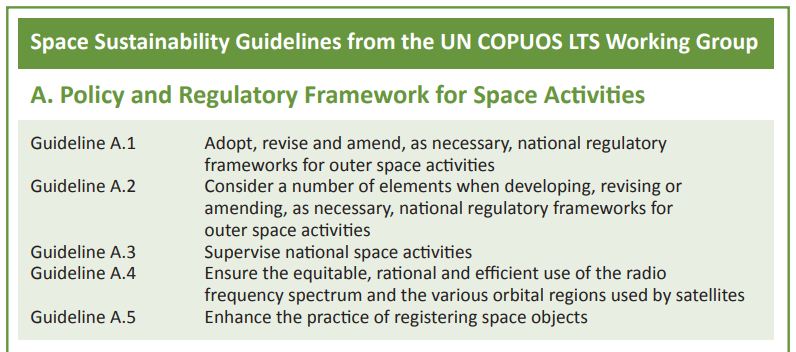
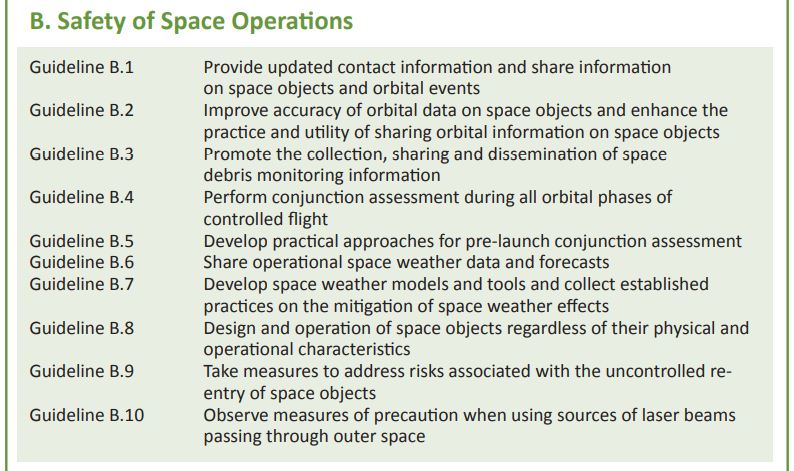

Artemis Accords
- This accord ensures that space exploration is conducted in a safe, sustainable and transparent manner and in full compliance with international law.
- As more countries establish a presence in outer space, via research stations, satellites, or even rocket launches, these accords provide a set of principles to create a safe and transparent environment that inspires exploration, science, and commercial activities.
“Astro Carta” for space sustainability
- The U.K. calls for an “Astro Carta” for space sustainability, based on the Artemis Accords model for sustainable space exploration. The U.K. Space Sustainability plan mentions four primary elements:
- to review the regulatory framework of the U.K.’s orbital activity;
- to work with organisations such as the G-7 and the UN to emphasise international engagement on space sustainability;
- to try and develop safety and quality-related metrics that quantify the sustainability of activities; and,
- to induce additional funding of $6.1 million on active debris removal. The U.K. also confirmed investments in its National Space Surveillance and Tracking Programme, which works on collision assessment services for U.K.-licenced satellite operators.
ClearSpace-1 Mission
- In this a "chaser" with its four robotic arms will grab the leftover of 2013 craft known as VESPA (Vega Secondary Payload Adapter) and drag it down to Earth's atmosphere where both will burn up. To be launched in 2025.
NEO-01’
- China launched a low Earth orbit robot prototype called ‘NEO-01’.
- It can scoop up space debris left behind by other spacecraft with a big net.
- NEO-01, was launched on Long March 6 rocket.
- NEO-01 will use a net to capture space debris and then burn it with its electric propulsion system.
- The NEO-01, will also peer into deep space to observe small celestial bodies.
- The 30kg robot will pave the way for future technologies capable of mining on asteroids.
Starship
- Space X Starship – the passenger‑carrying spacecraft once ready can collect and de-orbit space junk apart as well.
Conference on Disarmament (CD)
- The CD is the international forum for negotiating arms control and disarmament matters. One of its core focus areas is the prevention of an arms race in outer space (PAROS). As such, the subject of space and security weapons falls under its purview. The UN Institute for Disarmament Research (UNIDIR) helps provide decision-level information to the CD and identifies potential flashpoints that may lead to an arms race in outer space.
“Draft International Code of Conduct on Outer Space Activities”
- This is for consideration by the world community, a UNGA Group of Governmental Experts (GGE) on possible transparency and confidence-building measures (TCBMs) for space, and the establishment of a Working Group on the Long-Term Sustainability (LTS) of Outer Space Activities by the United Nations Committee on the Peaceful Uses of Outer Space (UN COPUOS).
Secure World Foundation
- Secure World Foundation is a private operating foundation working with governments, industry, international organizations, and civil society to develop and promote ideas and actions to achieve the secure, sustainable, and peaceful uses of outer space benefiting Earth and all its peoples.
ISRO’s Efforts
‘Project NETRA’
The Indian Space Research Organisation (ISRO) has initiated ‘Project NETRA’ to monitor space debris. The domestic surveillance system would provide first-hand information on the status of debris, which would aid further planning on protecting space assets.
‘SPADEX’
To provide in-orbit servicing, ISRO is developing a docking experiment called ‘SPADEX’. It looks at docking a satellite on an existing satellite, offering support in re-fuelling and other in-orbit services while enhancing the capability of a satellite. This would not only ensure the longevity of a mission but would also provide a futuristic option to combine missions/experiments.
Other
- In April 2022, India and the U.S. signed a new pact for monitoring space objects at the 2+2 dialogue.
- ISRO’s GSLV employs passivation of the Cryogenic Upper Stage at the end of its useful mission.
Way Ahead
- While most National Space Programs set sustainability standards, a collective effort by all space players, with the active role of the UN COPUOS or the United Nations Office for Outer Space Affairs (UNOOSA), is needed to set equitable standards for the ease of activities.
- Many of the measures for sustainability are resource-consuming and expensive for medium-and-small space programs. In this case, private initiatives of sustainability standards would make accessibility more challenging, giving undue advantage to programs with stable investments.
- More clarity is required to know the exact framework and guiding principles of the Astro Carta to determine the path it intends to take.
- India has always emphasized cost-effective and efficient missions with problem-solving applications. Its debris footprint is minuscule; it has 114 debris among the 25,182 pieces, of sizes larger than 10 cm, in the lower earth orbits.
- The emerging private sector could be encouraged with a set of sustainability guidelines to ensure optimum utilisation of resources and increase the safety and productivity of missions.
- Sustainable practices in outer space would directly help reduce orbital crowding and collision risk while nurturing future technologies. As the natural course of evolution, the Plan for Space Sustainability, which includes private industries, is a timely move. This would serve as a model for other space programmes.
https://epaper.thehindu.com/Home/ShareArticle?OrgId=GG9A0F3G3.1&imageview=0









